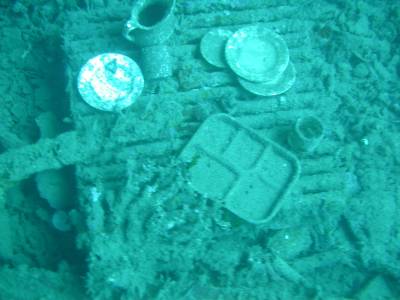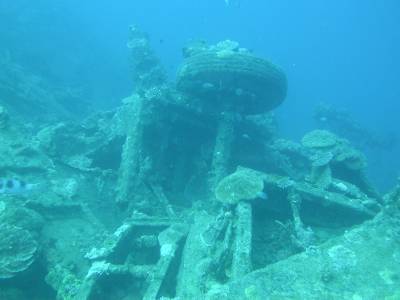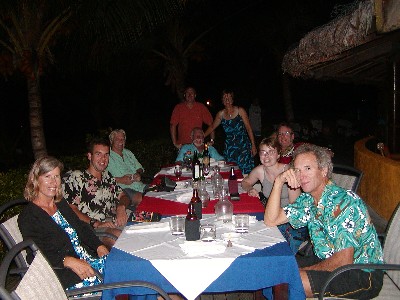For an explanation of photos,
position mouse over photo.
 A
beautiful and comfortable day sail brought us to our next destination,
Luganville on the island of Espiritu Santo. Luganville is the site of the wreck
of the SS President Coolidge which sank in the harbor after hitting two US
mines. The Coolidge was a former luxury liner converted to a troop ship in WWII.
It was operated by the merchant marine and was carrying over 5000 troops as it
entered Luganville Harbor. Unbeknownst to the civilian captain, the US military
had placed mines to guard the harbor entrance. The Coolidge struck two mines and
sank within 90 minutes after getting very close to shore. All but four of the
crew and troops escaped. The Coolidge is now a national park and one of the most
famous wreck dives in the world. Being so close to shore, it is very accessible
and it also still has much of its original equipment and cargo on board. Its bow
in in about 90 feet of water and its stern is at about 200 feet, meaning that
most of the dives are fairly deep, at around 150 feet.
A
beautiful and comfortable day sail brought us to our next destination,
Luganville on the island of Espiritu Santo. Luganville is the site of the wreck
of the SS President Coolidge which sank in the harbor after hitting two US
mines. The Coolidge was a former luxury liner converted to a troop ship in WWII.
It was operated by the merchant marine and was carrying over 5000 troops as it
entered Luganville Harbor. Unbeknownst to the civilian captain, the US military
had placed mines to guard the harbor entrance. The Coolidge struck two mines and
sank within 90 minutes after getting very close to shore. All but four of the
crew and troops escaped. The Coolidge is now a national park and one of the most
famous wreck dives in the world. Being so close to shore, it is very accessible
and it also still has much of its original equipment and cargo on board. Its bow
in in about 90 feet of water and its stern is at about 200 feet, meaning that
most of the dives are fairly deep, at around 150 feet.

To dive on the Coolidge you must go out with a local dive operator. We signed
up with Allan Powers, who has spent the past 33 years exploring, protecting, and
leading dives on the Coolidge. We did a total of five dives on the Coolidge and
could easily have done five more! The first was a warm up dive to the Promenade
Deck, going to a depth of 120 feet. Diving to this depth means you have limited
time as the deeper you go, the more rapidly you consume air. It also means that
you have to do decompression stops on the way up, so you need to be sure to have
enough air for that. Fortunately, the dive operators have spare air tanks
located at various strategic places. During the course of our diving, we would
be glad of that!
 During
our visit to the promenade deck, we passed the bow of the ship and were able to
see guns, helmets, china and eating utensils, and various other well preserved
items. Our next dive was the most popular dive on the Coolidge, a visit to "The
Lady", a large painting of a lady and a unicorn which hangs on the wall of the
main salon. It is a "penetration" dive, meaning you have to go inside the ship
and it takes you to a depth of 140 feet. Again, there were many fascinating
things to see along the way and "The Lady" is really magnificent. Of course it
is pretty dark at that depth, especially inside a ship where the sun can't
reach, so the only way to see anything is by the light of a dive light.
Nevertheless, it is quite enthralling! After our tour of The Lady, we headed up
to our decompression stops (5 minutes at 25 feet, 5 minutes at 15 feet and 10
minutes at 10 feet) where there is a coral garden and abundant fish life. The
fish are very used to divers and are fed by them regularly, so they are quite
friendly. We also helped to hunt the Crown of Thorns starfish, a creature that
multiplies rapidly and does great harm to coral reefs. They are an increasing
problem in the reefs across the Pacific and are very difficult to control. Every
day, the divemasters removed 20 or more from the small reef at the Coolidge. Our
next dive took us to the cargo holds. This allowed us to explore numerous nooks
and crannies within the ship and to see Jeeps, half-tracks, Howitzers, and lots
of other items that are still in the cargo holds.
During
our visit to the promenade deck, we passed the bow of the ship and were able to
see guns, helmets, china and eating utensils, and various other well preserved
items. Our next dive was the most popular dive on the Coolidge, a visit to "The
Lady", a large painting of a lady and a unicorn which hangs on the wall of the
main salon. It is a "penetration" dive, meaning you have to go inside the ship
and it takes you to a depth of 140 feet. Again, there were many fascinating
things to see along the way and "The Lady" is really magnificent. Of course it
is pretty dark at that depth, especially inside a ship where the sun can't
reach, so the only way to see anything is by the light of a dive light.
Nevertheless, it is quite enthralling! After our tour of The Lady, we headed up
to our decompression stops (5 minutes at 25 feet, 5 minutes at 15 feet and 10
minutes at 10 feet) where there is a coral garden and abundant fish life. The
fish are very used to divers and are fed by them regularly, so they are quite
friendly. We also helped to hunt the Crown of Thorns starfish, a creature that
multiplies rapidly and does great harm to coral reefs. They are an increasing
problem in the reefs across the Pacific and are very difficult to control. Every
day, the divemasters removed 20 or more from the small reef at the Coolidge. Our
next dive took us to the cargo holds. This allowed us to explore numerous nooks
and crannies within the ship and to see Jeeps, half-tracks, Howitzers, and lots
of other items that are still in the cargo holds.
We took a break from the Coolidge to dive at Million Dollar Point, named
because of the value of the equipment the US government drove off a jetty into
the sea after the war when they failed to reach an agreement with the French
government to purchase it. Apparently afraid the equipment would fall into enemy
hands, the US government decided to scuttle it - and yes, it was a LOT of stuff.
It's not a real scenic dive site, but it is worth doing once, just to see the
magnitude of stuff that is dumped there. There are dozens of jeeps and
bulldozers, tons (literally) of raw building materials such as steel rods,
trucks, tires, batteries and even a ship. The coral is not terribly
abundant or colorful, but there are some very interesting examples of coral
formation growing on old truck tires.
Next it was back to the Coolidge for our final two dives. The first took us
to the engine rooms and our deepest depth at 152 feet! This depth is actually
beyond the recommended limits of recreational diving and is honestly something I
never thought I would do! But with an experienced divemaster and plenty of spare
air, we felt safe. We were able to see the huge engines that powered the ship
and then we went through a small opening into the control room where we could
see all the guages on the wall.
 As
we emerged from the engine room, Ron gave the "low air" signal. We were only
half way through the dive and were still at 150 feet, so this was not good!
Gary, our divemaster, went to assist Ron and gave him his spare air hose. After
an adjustment to his tank, Ron's air was flowing again - apparently he had some
kind of kink or obstruction in his regulator, so we were off to swim our way up
the smokestack and through the ship on the way to our decompression stop. By the
time we reached it, Ron and I were both very low on air so we shared a spare
tank for the last 15 minutes of decompression. Not a problem, but we certainly
had to stay together!
As
we emerged from the engine room, Ron gave the "low air" signal. We were only
half way through the dive and were still at 150 feet, so this was not good!
Gary, our divemaster, went to assist Ron and gave him his spare air hose. After
an adjustment to his tank, Ron's air was flowing again - apparently he had some
kind of kink or obstruction in his regulator, so we were off to swim our way up
the smokestack and through the ship on the way to our decompression stop. By the
time we reached it, Ron and I were both very low on air so we shared a spare
tank for the last 15 minutes of decompression. Not a problem, but we certainly
had to stay together!
On the drive to the dive site, someone had asked whether there are any snakes
native to Vanuatu. Allan Powers said there is a small, but harmless python that
is fairly common. When we emerged from our first dive of the day, there was
Allan holding a snake he had just found in the woods. After just a few minutes
it was already quite tame and very cute. Nobody but me wanted to hold him, but
we hit it off just fine. After a short visit, we let him go back to the woods he
came from.
 Our
final dive took us to the medical center and pharmacy where we saw many medical
supplies still intact. This was a fun dive as it took us through many small
openings and dark passageways. By this time I was quite comfortable with the
depth and the close quarters, so I really enjoyed this dive. But before we knew
it, it was over and we headed back for some more decompression.
Our
final dive took us to the medical center and pharmacy where we saw many medical
supplies still intact. This was a fun dive as it took us through many small
openings and dark passageways. By this time I was quite comfortable with the
depth and the close quarters, so I really enjoyed this dive. But before we knew
it, it was over and we headed back for some more decompression.
During our week in Luganville, we had a chance to spend more time with our
new friends G.B. and Sarah from the sailboat Djarrka and Ken and Kathy from
Felicity. We also met two English medical students, Richard and Helen, who were
working for a couple months at the local hospital and two honeymoon couples,
Wayne and Kelley from Australia who were staying at the local resort, and Terry
and Eleanor who were diving with us. We all attended "Island Night" at the local
resort and had several fun get togethers. Hopefully, our paths will cross again
someday. But now it's time for us to say goodbye to Vanuatu and head back to
Australia before the cyclone season begins!
SEE MORE PHOTOS - CLICK HERE













![]()
